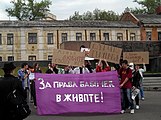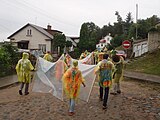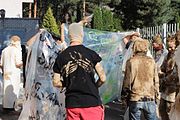Government outrage
In 2014, Artyom Loskutov attempted to organize a routine monstration for August 17, when he ran into trouble. "We were talking about having a march, which is absolutely allowed under law," Loskutov says. "But in writing about it, we wrote about creating a Siberian Republic within the Russian Federation. There was no talk about separatism or anything, it's just that Moscow doesn't govern the regions very effectively." [9]
The purpose of the protest was to ridicule Kremlin's hypocrisy in the Annexation of Crimea by the Russian Federation and to raise awareness about politics in Siberia. "They decided to tell us how great it is when some republic moves for self-determination. Okay, well let's apply this to other regions. Can Siberia allow itself this same rhetoric? It turns out it can't." [10]
Russian telecommunications regulator Roskomnadzor launched a media blackout of the event, issued warnings to 14 media outlets that ran the story and threatened to close BBC Russian Service for reporting the announcement. [11] Roskomnadzor also launched an official investigation against BBC to confirm "an apparent violation of the law." In response, BBC added a description of the event as a “parody” that in no way promoted Siberia's independence from Moscow. [12]
Russian authorities compared the potential monstration protest to Euromaidan that led to the 2014 Ukrainian revolution. Nikolai Valuyev called it the "first attempt of global efforts to promote separatism in Russia." [13]
According to Dmitry Zhuravlyov, director of Institute for Regional Problems based in Moscow, "I can understand the position of these people [organizers of the march] on a psychological level," Zhuravlyov said. "They want to have more control over the riches of Siberia, and that is understandable. But what is unacceptable to Russia is that this whole idea goes against the Constitution. You cannot change the status of your region just like that." President Vladimir Putin recently signed legislation that introduced prison sentences for violations of territorial integrity in Russia. [14]
This page is based on this
Wikipedia article Text is available under the
CC BY-SA 4.0 license; additional terms may apply.
Images, videos and audio are available under their respective licenses.








